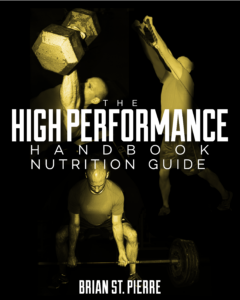
A Glimpse Inside The High Performance Handbook Nutrition Guide – Part 1
I’ve received some questions about what one can expect from Nutrition Guide that accompanies The High Performance Handbook Gold Package, so I thought I’d use today’s post to highlight a few “Ah-Ha” moments from Brian St. Pierre’s awesome contribution. For those who aren’t familiar with “BSP,” he’s one of Dr. John Berardi’s right-hand-men at Precision Nutrition. Check out these thought provoking ideas directly from the text:
Point #1: The Dairy and Diabetes Risk Relationship
With little fanfare, a study recently came out by Dr. Dariush Mozaffarian and colleagues. Why so little fanfare, you ask? It’s because the study suggests that dairy fat may actually protect against diabetes, and that goes against conventional wisdom and government recommendations.
Dr. Mozaffarian and company collected two measures of dairy fat intake in 3,736 Americans. They took six 24-hour dietary recall questionnaires, as well as assessing blood levels of trans-palmitoleate. Trans-palmitoleate comes almost exclusively from dairy fat and red meat fat, and therefore it reflects the intakes of these foods. Dairy provided most of the trans-palmitoleate fatty acid in this study.
Adjustments were made for confounding factors, and trans-palmitoleate levels were associated with a smaller waist circumference, higher HDL cholesterol, lower serum triglycerides, lower C-reactive protein (a marker of inflammation), lower fasting insulin and lower calculated insulin resistance. In addition, people who had the highest levels of trans-palmitoleate had 1/3 the risk of developing diabetes over the 3-year study period.
Again, it is important to note that trans-palmitoleate is a fatty acid, and so is only provided in significant amounts by whole fat dairy, not from low-fat or fat-free versions. The investigators also noted that “greater whole-fat dairy consumption was associated with lower risk for diabetes.” This is an important distinction, as it wasn’t just trans-palmitoleate levels that were associated with the decreased risk, but the actual consumption of whole-fat dairy itself that seemingly provides the benefit.
Here’s another nice quote from the authors: “Our findings support potential metabolic benefits of dairy consumption and suggest that trans-palmitoleate may mediate these effects. They also suggest that efforts to promote exclusive consumption of low-fat and non-fat dairy products, which would lower population exposure to trans-palmitoleate, may be premature until the mediators of the health effects of dairy consumption are better established.”
While it is certainly possible that trans-palmitoleate is mediating a lot of these positive health outcomes that were associated with it, in all reality, it only makes up a tiny fraction of the fat content of milk. I tend to believe that instead, it is more of a marker of dairy fat intake, with the benefits more likely coming from the other elements contained in dairy fat – CLA, vitamin K2, butyric acid, vitamin D – in addition to the trans-palmitoleate.
Point #2: Sleep: Why We Need It, and How To Get It
We all know that sleep is important for our health. However, many of us (if not most of us) tend to act as if that just doesn’t hold true for ourselves. We seem to believe that we can get away with it. While you may blame “work” or simply being “busy,” research clearly and consistently shows that people miss out on sleep due to something called “voluntary bedtime delay.” Basically, we stay up late because we want to, often watching “Keeping Up With the Kardashians” re-runs, or mindlessly reading useless info on Facebook. No matter the reason, it is unlikely to actually be more important than logging sufficient and quality shut-eye.
In the big picture, sleep is just as important as nutrition and exercise when it comes to improving your health, performance, and body composition.
The average adult gets about 6 hours and 40 minutes of sleep per night. In fact, about 30% of the population gets fewer than six hours per night. Women tend to sleep a bit more than men, and people who carry high amounts of body fat tend to sleep less than those with a normal body fat level. Studies suggest that people who sleep fewer than six hours per night gain almost twice as much weight over a 6-year period as people who sleep 7-8 hours per night.
Excessive sleep isn’t necessarily better, either; those who sleep more than nine hours per night have similar body composition outcomes as those who sleep less than six hours.
There is a fairly strong body of research showing that lack of sleep increases risk of many conditions, including:
- altered food intake
- decrease in satiety hormones, increase in hunger hormones
- increase in pleasure response to food, causing increased food intake
- altered glucose tolerance, insulin resistance & diabetes
- inflammation
- obesity
- disruption of cortisol levels and rhythm
- decrease in testosterone and increase in estrogen
- loss of lean mass, including muscle, bone and organs (such as your brain)
- decrease in thyroid stimulating hormone
- heart attack
- stroke
It is important to note that sleep debt is cumulative, meaning that the more nights with less sleep, the greater likelihood of negative effects taking place. The good news is that you can catch up with just a few consecutive nights of adequate sleep. Experts hypothesize that each hour of sleep debt needs to be repaid eventually, so don’t let it add up.
Okay, so we know lack of sleep is a problem. As researchers have noted regarding sleep debt: “these alterations are similar to those observed during aging and sometimes during depression.” Awesome.
Fortunately, research also shows that simply getting adequate sleep can quickly right the ship on these issues. [Note from EC: Brian goes into great detail on strategies to improve sleep quality and duration in his guide].
I’ll be back later today with a few more key points from BSP’s manual, but in the meantime, you can check out The High Performance Handbook here. Don’t forget: the $30 off discount is only around for this week!



